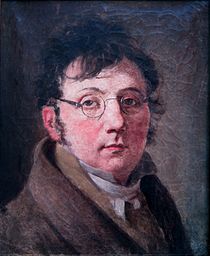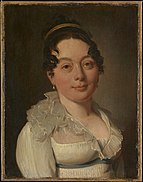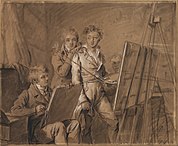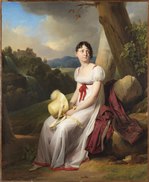Louis-Léopold Boilly
Louis-Léopold Boilly | |
|---|---|
 Self-portrait c. 1805 | |
| Born | Louis-Léopold Boilly 5 July 1761[1] La Bassée, France |
| Died | 4 January 1845 (aged 83) Paris, France |
| Nationality | French |
| Known for | Portrait painting, genre painting |
Louis-Léopold Boilly (French:
Life and career



Boilly was born in
At the height of the revolutionary Terror in 1794, Boilly was condemned by the Committee of Public Safety for the erotic undertones of his work.[6] This offence was remedied by Boilly's eleventh-hour production of the more patriotic Triumph of Marat (now in the Musée des Beaux Arts, Lille) which saved him from serious penalties.[6]
Boilly was a popular and celebrated painter of his time. He was among the first artists to produce
Boilly died in Paris on 4 January 1845.[2] His youngest son, Alphonse Boilly (1801–1867), was a professional engraver who apprenticed in New York with Asher Brown Durand.[7]
Style and works

Boilly's early works showed a preference for amorous and moralising subjects. The Suitor's Gift is comparable to much of his work in the 1790s. His small-scale paintings with carefully mannered colouring and precise detailing recalled the work of
(1617–1681), of whose work Boilly owned an important collection.After 1794, Boilly began to produce far more crowded compositions that serve as social chronicles of the urban middle class.[8] In these works, his observation of contemporary customs is slightly sentimental and often humorous.[6]
Boilly was also well respected for his portraiture. By the end of his lifetime he had painted about 5,000 portraits, most of which were painted on canvases measuring 22 cm x 17 cm (8 5/8 in. x 6 5/8 in.).
Boilly used his great skill in depicting textures to produce numerous illusionistic works, including paintings in grisaille that mimic prints.[6] In the Salon of 1800 he exhibited a painting that depicted layers of overlapping prints, drawings, and papers, covered by a sheet of broken glass in a wooden frame. His title for the work, Un trompe-l'œil ("a trick played on the eye"), marked the first use of that term to describe an illusionistic painting. Although art critics derided the painting as a stunt, it caused a popular sensation, and trompe-l'œil entered the language as a name for an entire genre.[9]
His interest in caricature is most apparent in his suite of 98 lithographs titled Recueil de grimaces, published between 1823 and 1828.[10]
Boilly remains a highly regarded master of oil painting. A major exhibition of his work, The Art of Louis-Léopold Boilly: Modern Life in Napoleonic France, travelled to the United States where it was shown at both the Kimbell Art Museum in Fort Worth and the National Gallery of Art in Washington (1995).[11] The Musée des Beaux Arts in Lille held a large-scale exhibition of Boilly's work during the winter season of 2011–2012.[12]
Selected works
-
Self-portrait c. 1793
-
La Toilette intime
-
Robespierre
-
The Suitor's Gift, c. 1790, Royal Scottish Academy
-
Portrait of Jan Anthony d'Averhoult, 1792, Centraal Museum
-
Portrait of a Woman, Metropolitan Museum of Art
-
Three Young Artists in a Studio
-
Houdon, c. 1803
-
Portrait of Charles-Louis Havas
-
Young Harpist, c. 1804–1806
-
L'effet du mélodrame, 1830
-
Une loge, 1830
-
Trompe-l'œil with a cat and a wooden log through a canvas, fish hanging from the stretcher
-
Madame Saint-Ange Chevrier, 1807, Nationalmuseum
References
- ISBN 9781857096439.
- ^ OCLC 4537324. Retrieved 2 August 2011.
- OCLC 3677192. Retrieved 2 August 2011.
- ^ "The J. Paul Getty Museum: Louis-Léopold Boilly". J. Paul Getty Trust. 2011. Archived from the original on 6 December 2009. Retrieved 2 August 2011.
- ISBN 978-2-86770-016-3. Retrieved 2 August 2011.
Il a été élève du peintre de trompe-lœil Dominique Doncre.
- ^ a b c d e f Chaudonneret, M.arie-Claude (2003, January 01). "Boilly, Louis-Léopold". Grove Art Online.
- ISBN 978-0-943651-05-7. Retrieved 2 August 2011.
- ^ a b c Taws, Richard (9 May 2019). "At the National Gallery". London Review of Books 40 (9): 26–27.
- ISBN 9781857096439.
- ISBN 9781857096439.
- ^ Etienne Bréton, Pascal Zuber (2011). "Catalogue Raisonné de Louis Léopold Boilly" (in French). Archived from the original on 21 July 2011. Retrieved 2 August 2011.
- ^ "Exposition Boilly". Pba-lille.fr. Palais des Beaux Arts de Lille. 2012. Retrieved 8 March 2012.
Further reading
- The Art of Louis-Léopold Boilly: Modern Life in Napoleonic France by Susan L. Siegfried (Yale University Press, 1995)
- Romanticism & the school of nature : nineteenth-century drawings and paintings from the Karen B. Cohen collection by Colta Feller Ives (The Metropolitan Museum of Art, 2000)
External links
- Biography and links to many works {World Wide Art Resources}. Careful: all kinds of pop-ups and dead links here.
- The Art of Louis-Léopold Boilly {Book Review}
- . New International Encyclopedia. 1905.














